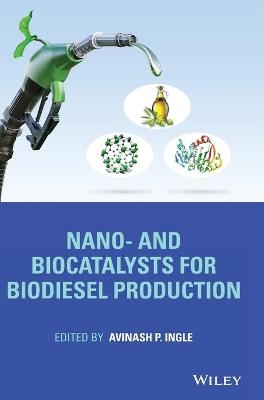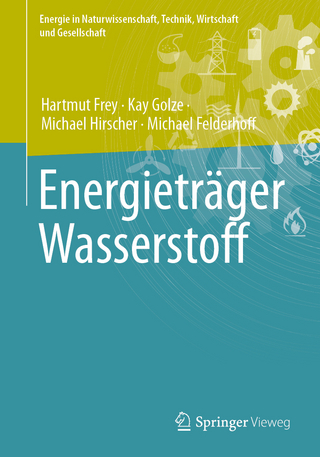
Nano- and Biocatalysts for Biodiesel Production
John Wiley & Sons Inc (Verlag)
978-1-119-73000-2 (ISBN)
Nano- and Biocatalysts for Biodiesel Production delivers an essential reference for academic and industrial researchers in biomass valorization and biofuel industries. The book covers both nanocatalysts and biocatalysts, bridging the gap between homogenous and heterogenous catalysis.
Readers will learn about the techno-economical and environmental aspects of biodiesel production using different feedstocks and catalysts. They will also discover how nano(bio)catalysts can be used as effective alternatives to conventional catalysts in biodiesel production due to their unique properties, including reusability, high activation energy and rate of reaction, easy recovery, and recyclability.
Readers will benefit from the inclusion of:
Introductions to CaO nanocatalysts, zeolite nanocatalysts, titanium dioxide-based nanocatalysts and zinc-based in biodiesel production
An exploration of carbon-based heterogeneous nanocatalysts for the production of biodiesel
Practical discussions of bio-based nano catalysts for biodiesel production and the application of nanoporous materials as heterogeneous catalysts for biodiesel production
An analysis of the techno-economical considerations of biodiesel production using different feedstocks
Nano- and Biocatalysts for Biodiesel Production focuses on recent advances in the field and offers a complete and informative guide for academic researchers and industrial scientists working in the fields of biofuels and bioenergy, catalysis, biotechnology, bioengineering, nanotechnology, and materials science.
Avinash P. Ingle, PhD, is currently working as Ramanujan Fellow at Department of Biotechnology, Dr. Panjabrao Deshmukh Krishi Vidyapeeth, Akola, Maharashtra, India. His research focus is on nanobiotechnology and nano-biofuel technology and he has over 10 years of research experience in the field of nanotechnology.
Preface xv
List of Contributors xix
1 Biodiesel: Different Feedstocks, Conventional Methods, and Factors Affecting its Production 1
Hossein Esmaeili and Sajad Tamjidi
1.1 Introduction 1
1.2 Different Feedstocks for Biodiesel Production 3
1.2.1 Vegetable Sources 3
1.2.2 Waste Oils 3
1.2.3 Animal Fats 5
1.2.4 Microalga Oil 6
1.3 Conventional Methods of Biodiesel Production 8
1.3.1 Microemulsion 8
1.3.2 Pyrolysis or Thermal Cracking 8
1.3.3 Transesterification 8
1.4 Catalysts Used in Biodiesel Production 9
1.4.1 Homogeneous Catalysts 9
1.4.1.1 Homogeneous Alkaline Catalysts 9
1.4.1.2 Homogeneous Acidic Catalysts 9
1.4.2 Heterogeneous Catalysts 10
1.4.2.1 Heterogeneous Alkaline Catalysts 10
1.4.2.2 Heterogeneous Acid Catalysts 10
1.4.3 Enzymatic Catalysts 11
1.4.4 Nanocatalysts 12
1.5 Effects of Different Factors on Biodiesel Production Yield 15
1.5.1 Reaction Temperature 15
1.5.2 Alcohol to Oil Molar Ratio 16
1.5.3 Reaction Time 17
1.5.4 Catalyst Dosage 17
1.5.5 pH 17
1.5.6 Mixing Rate 17
1.5.7 Fatty Acids 18
1.5.8 Water Content 18
1.6 Physical Properties of Biodiesel 18
1.7 Conclusions 19
References 20
2 Nano(Bio)Catalysts: An Effective Tool to Utilize Waste Cooking Oil for the Biodiesel Production 31
Rushikesh Fopase, Swati Sharma and Lalit M. Pandey
2.1 Introduction 31
2.2 Waste Cooking Oils 33
2.3 Pretreatment of WCOs 33
2.4 Transesterification Process 34
2.4.1 Kinetics of Transesterification 36
2.5 Enzymatic Biocatalysts 37
2.5.1 Lipases 38
2.5.1.1 Extracellular Lipases 38
2.5.1.2 Intracellular Lipases 39
2.6 Enzyme Immobilization Techniques 41
2.7 Physical Methods 42
2.7.1 Adsorption 42
2.7.2 Encapsulation 45
2.7.3 Entrapment 46
2.8 Chemical Methods 47
2.8.1 Covalent Bonding 47
2.8.2 Cross-Linking 49
2.8.3 Summary 50
2.9 Conclusions 50
References 51
3 A Review on the Use of Bio/Nanostructured Heterogeneous Catalysts in Biodiesel Production 59
Samuel Santos, Jaime Puna, João Gomes and Jorge Marchetti
3.1 Introduction 59
3.2 Use of Micro- and Nanostructured Heterogeneous Catalysts in Biodiesel Production 62
3.2.1 Microstructured Heterogeneous Catalysts 62
3.2.1.1 Solid Acid Catalysts 62
3.2.1.2 Solid Base Catalysts 63
3.2.2 Nanostructured Heterogeneous Catalysts 65
3.2.2.1 Gas Condensation 65
3.2.2.2 Vacuum Deposition 65
3.2.2.3 Chemical Deposition 66
3.2.2.4 Sol-Gel Method 66
3.2.2.5 Impregnation 67
3.2.2.6 Nanogrinding 68
3.2.2.7 Calcination-Hydration-Dehydration 68
3.3 Enzymatic Catalysis 69
3.3.1 Heterogeneous Biocatalysts (Lipases) and Their Immobilization 69
3.3.1.1 Physical Adsorption 70
3.3.1.2 Entrapment 70
3.3.1.3 Covalent Bonding 71
3.3.1.4 Cross-Linking 72
3.3.2 Nano(Bio)Catalysts: Immobilization of Enzymes on Nanosupports 73
3.3.2.1 Nanoparticles 73
3.3.2.2 Carbon Nanotubes 75
3.3.2.3 Nanofibers 76
3.3.2.4 Nanocomposites 76
3.4 Conclusions 77
References 78
4 Calcium-Based Nanocatalysts in Biodiesel Production 93
Priti R. Pandit and Archit Mohapatra
4.1 Introduction 93
4.2 Nanocatalysts 94
4.3 CaO-Based Nanocatalysts for Biodiesel Production 95
4.3.1 Synthesis and Characterization of CaO-Based Nanocatalysts Using Waste Material 99
4.3.2 CaO Nanocatalysts Supported with Metal Oxides for Biodiesel Production 102
4.4 Effects of Different Parameters on Biodiesel Production 105
4.4.1 Reaction Time 105
4.4.2 Temperature 105
4.4.3 Methanol to Oil Molar Ratio 106
4.4.4 Catalyst Load 106
4.5 Reusability and Leaching of Nanocatalysts 106
4.6 Conclusions 107
References 107
5 Titanium Dioxide-Based Nanocatalysts in Biodiesel Production 115
Elijah Olawale Ajala, Mary Adejoke Ajala and Harvis Bamidele Saka
5.1 Introduction 115
5.2 Natural Occurrences of Titania 117
5.2.1 Rutile 117
5.2.2 Anatase 118
5.2.3 Rhombic Brookite 118
5.2.4 Kaolin Clays 118
5.2.5 Ilmenites or Manaccanite 120
5.3 Precursors Used for the Synthesis of TiO2 NPs 120
5.3.1 Titanium Tetrachloride 121
5.3.2 Titanium Tetraisopropoxide 121
5.3.3 Titanium Butoxide 122
5.4 Methods for the Synthesis of TiO2 NPs 122
5.4.1 Physical Methods 122
5.4.1.1 Ball Milling 122
5.4.1.2 Laser Ablation/Photoablation 123
5.4.1.3 Sputtering 123
5.4.2 Chemical Methods 123
5.4.2.1 Microemulsion 123
5.4.2.2 Precipitation 124
5.4.2.3 Sol-Gel 124
5.4.2.4 Hydrothermal 125
5.4.2.5 Solvothermal 125
5.4.2.6 Electrochemical/Deposition 125
5.4.2.7 Sonochemical 126
5.4.2.8 Direct Oxidation 126
5.4.3 Biological Methods 126
5.4.3.1 Green Synthesis Using Plant Extracts 126
5.4.3.2 Microbial Synthesis 128
5.4.3.3 Enzyme-Mediated Synthesis 129
5.5 Methods for the Synthesis of TiO2-Based Nanocatalysts 130
5.5.1 Wet Impregnation 130
5.5.2 Dry Impregnation 131
5.6 TiO2-Based Nanocatalysts for Biodiesel Production 131
5.6.1 Sulfated TiO2 Nanocatalysts 131
5.6.2 Alkaline TiO2 Nanocatalysts 133
5.6.3 Co-Transition TiO2 Nanocatalysts 133
5.6.4 Alkali TiO2 Nanocatalysts 134
5.6.5 Bimetallic TiO2 Nanocatalysts 135
5.6.5.1 TiO2-Pd-Ni 135
5.6.5.2 TiO2-Au-Cu 135
5.7 Other TiO2 Nanocomposite Catalysts 135
5.8 Conclusions 136
References 136
6 Zinc-Based Nanocatalysts in Biodiesel Production 143
Avinash P. Ingle
6.1 Introduction 143
6.2 Feedstocks Used for Biodiesel Production 144
6.2.1 Vegetable Oils 144
6.2.2 Microbial Oils 145
6.2.3 Animal Fats 145
6.2.4 Waste Oils 145
6.2.5 Biomass 146
6.3 Conventional Methods of Biodiesel Production 146
6.3.1 Pyrolysis 146
6.3.2 Transesterification 146
6.3.2.1 Homogeneous Acid and Base (Alkali)-Catalyzed Transesterification 146
6.3.2.2 Heterogeneous Acid and Base (Alkali)-Catalyzed Transesterification 147
6.3.2.3 Enzymatic Transesterification 147
6.4 Nanotechnology in Biodiesel Production 148
6.5 Zinc-Based Nanocatalysts in Biodiesel Production 148
6.6 Conclusions 151
References 152
7 Carbon-Based Nanocatalysts in Biodiesel Production 157
Rahul Bhagat, Harris Panakkal, Indarchand Gupta and Avinash P. Ingle
7.1 Introduction 157
7.2 Feedstocks Used for Biodiesel Production 158
7.2.1 Vegetable Oils 158
7.2.2 Algae 159
7.2.3 Animal Fats 160
7.2.4 Waste Cooking Oils 160
7.3 Conventional Heterogeneous Catalysts 160
7.4 Carbon-Based Heterogeneous Nanocatalysts 164
7.4.1 Carbon Nanotubes 166
7.4.2 Sulfonated Carbon Nanotubes 167
7.4.3 Graphene/Graphene Oxide-Based Nanocatalysts 168
7.4.4 Carbon Nanofibers and Carbon Dots 169
7.4.5 Carbon Nanohorns 170
7.4.6 Other Carbon-Based Nanocatalysts 171
7.5 Conclusions 174
References 174
8 Functionalized Magnetic Nanocatalysts in Biodiesel Production 183
Kalyani Rajkumari and Lalthazuala Rokhum
8.1 Introduction 183
8.2 Relevance of Heterogeneous Catalysis in Biodiesel Production 185
8.3 Surface Modification and Functionalization of NPs 186
8.4 Applications of Functionalized Magnetic Nanocatalysts in Biodiesel Production 186
8.4.1 Acid-Functionalized Magnetic Nanocatalysts 186
8.4.2 Base-Functionalized Magnetic Nanocatalysts 189
8.4.3 Magnetic Nanocatalysts Functionalized withWaste Materials 190
8.4.4 Ionic Liquid-Immobilized Magnetic Nanocatalysts 192
8.5 Conclusions 194
References 195
9 Bio-Based Catalysts in Biodiesel Production 201
Umer Rashid, Shehu-Ibrahim Akinfalabi, Naeemah A. Ibrahim and Chawalit Ngamcharussrivichai
9.1 Introduction 201
9.2 Biodiesel: A Potential Source of Renewable Energy 204
9.2.1 Progress in Biodiesel Development 204
9.2.2 Development of Biodiesel in Malaysia 205
9.2.3 Biodiesel Feedstocks 206
9.2.3.1 PFAD as a Biodiesel Feedstock 207
9.2.4 Common Methods Used for Biodiesel Reaction 208
9.2.4.1 Esterification 209
9.2.4.2 Transesterification 210
9.3 Homogeneous Catalysis in Biodiesel Production 211
9.4 Heterogeneous Catalysis in Biodiesel Production 213
9.5 Catalyst Supports 215
9.5.1 Alumina 216
9.5.2 Silicate 216
9.5.3 Zirconium Oxide 217
9.5.4 Activated Carbon 217
9.6 Heterogeneous Bio-Based Acid Catalysts 217
9.7 Synthesis of Bio-Based Solid Acid Catalysts 218
9.7.1 Palm Tree Fronds and Spikelets 219
9.7.2 Jatropha curcas 219
9.7.3 Coconut Shells 220
9.7.4 Rice Husks 220
9.7.5 Bamboo 221
9.7.6 Cocoa Pod Husks 221
9.7.7 Hardwoods 222
9.7.8 Peanut Hulls 222
9.7.9 Wood Mixtures 223
9.7.10 Palm Kernel Shells 223
9.8 Magnetic Bio-Based Catalysts for Biodiesel Production 224
9.9 Characterization of Bio-Based Catalysts 228
9.9.1 Field Emission Scanning Electron Microscopy (FESEM) 228
9.9.2 Fourier Transform Infrared (FT-IR) 229
9.9.3 X-Ray Diffraction (XRD) 229
9.9.4 Thermogravimetric Analysis (TGA) 230
9.9.5 Temperature-Programmed Desorption – Ammonia (TPD-NH3) 231
9.9.6 Brunauer–Emmett–Teller (BET) Analysis 231
9.10 Reaction Parameters Affecting Biodiesel Production 232
9.10.1 Reaction Time 232
9.10.2 Catalyst Concentration 232
9.10.3 Methanol to Fat/Oil Molar Ratio 232
9.10.4 Reaction Temperature 233
9.10.5 Mixing Rate 235
9.11 Conclusions 235
References 236
10 Heterogeneous Nanocatalytic Conversion of Waste to Biodiesel 249
Nilutpal Bhuyan, Manash J. Borah, Neelam Bora, Dipanka Saikia, Dhanapati Deka and Rupam Kataki
10.1 Introduction 249
10.2 Role of Catalysts in Biodiesel Production 250
10.3 Feedstocks for Biodiesel Production 251
10.3.1 First-Generation Feedstocks or Edible Oils 251
10.3.2 Second-Generation Feedstocks or Non-Edible Oils 252
10.3.3 Third-Generation Feedstocks or Algae 252
10.3.4 Other Feedstocks 253
10.4 Biodiesel Production Process 253
10.4.1 Acid-Catalyzed Transesterification 254
10.4.1.1 Mechanism of Acid-Catalyzed Transesterification 256
10.4.2 Alkali- or Base-Catalyzed Transesterification 256
10.4.2.1 Mechanism of Alkali- or Base-Catalyzed Transesterification 258
10.4.3 Other Types of Transesterification 258
10.5 Variables Affecting Transesterification 259
10.6 Heterogeneous Nanocatalysts for Biodiesel Production 260
10.7 Characterization of Nanoparticles Used for Biodiesel Production 262
10.7.1 X-Ray Diffraction (XRD) 262
10.7.2 Scanning Electron Microscopy (SEM) 262
10.7.3 Energy Dispersive X-Ray Analysis (EDX) 262
10.7.4 Transmission Electron Microscopy (TEM) 264
10.7.5 Atomic Force Microscopy (AFM) 264
10.7.6 Raman Spectroscopy 264
10.7.7 Fourier Transform Infrared Spectroscopy (FT-IR) 264
10.7.8 X-Ray Photoelectron Spectroscopy (XPS) 264
10.7.9 Thermogravimetric Analysis (TGA) 265
10.8 Influence of Nanoparticle Properties on Biodiesel Production 265
10.9 Safety Issues Around the Application of Nanocatalysts in Biodiesel Production 267
10.10 Future Perspectives 267
10.11 Conclusions 268
References 269
11 Application of Rare Earth Cation-Exchanged Nanozeolite as a Support for the Immobilization of Fungal Lipase and their Use in Biodiesel Production 279
Guilherme de Paula Guarnieri, Adriano de Vasconcellos, Fábio Rogério de Moraes and José Geraldo Nery
11.1 Introduction 279
11.2 Case Study 282
11.2.1 Origins of Materials and Enzymes 282
11.2.2 Preparation of Na-FAU Nanozeolites 282
11.2.3 Ion-Exchange Experiments 283
11.2.4 Enzyme Immobilization on to Nanozeolitic Supports 283
11.2.5 Physicochemical Characterization of As-Synthesized Nanozeolites and Nanozeolite–Enzyme Complexes 284
11.2.6 Synthesis of FAAEs 286
11.2.7 FAEE Yields Obtained with Nanozeolite Complexes 287
11.2.8 Model of Lipase Immobilization on to Zeolite Supports 287
11.3 Conclusions 290
References 290
12 Lipase-Immobilized Magnetic Nanoparticles: Promising Nanobiocatalysts for Biodiesel Production 295
Tooba Touqeer, Muhammad Waseem Mumtaz and Hamid Mukhtar
12.1 Introduction 295
12.2 Transesterification for Biodiesel Production 296
12.2.1 Homogenous Catalysts 296
12.2.2 Heterogeneous Catalysts 297
12.2.3 Enzymatic Catalysts 297
12.3 Advantages of Using Magnetic Nanobiocatalysts 297
12.3.1 High Enzyme Loading and Surface Area to Volume Ratio 298
12.3.2 Low Mass Transfer Restriction and High Brownian Movement 299
12.3.3 Effortless Recovery and Reusability 299
12.3.4 Stability 299
12.4 Synthesis of Nanobiocatalysts 299
12.4.1 Preparation and Functionalization of Nanostructures 299
12.4.2 Immobilizing Enzymes on Nanomaterials 300
12.4.2.1 Adsorption Immobilization 300
12.4.2.2 Covalent Immobilization 301
12.5 Techniques for the Characterization of Nanobiocatalysts 302
12.6 Transesterification Using Magnetic Nanobiocatalysts 303
12.7 Factors Affecting Enzymatic Transesterification 304
12.7.1 Type of Alcohol Used 304
12.7.2 Solvent 305
12.7.3 Reaction Temperature 306
12.7.4 Water Content 306
12.7.5 Alcohol to Oil Molar Ratio 306
12.7.6 Source of Lipase 306
12.8 Conclusions 307
References 307
13 Technoeconomic Analysis of Biodiesel Production Using Different Feedstocks 313
Shemelis Nigatu Gebremariam
13.1 Introduction 313
13.2 Biodiesel Production Technologies 315
13.3 Feedstock Types for Biodiesel Production 317
13.4 Technical Performance Evaluation of Biodiesel Production 318
13.4.1 Fuel Properties of Biodiesel 319
13.4.1.1 Flash Point 319
13.4.2 Cold Flow Properties 319
13.4.2.1 Cloud Point 320
13.4.2.2 Pour Point 320
13.4.2.3 Cold Filter Plugging Point (CFPP) 321
13.4.3 Cetane Number 321
13.4.4 Density 322
13.4.5 Viscosity 323
13.4.6 Oxidation Stability 323
13.4.7 Biodiesel Quality Standards 324
13.5 Economic Performance Evaluation of the Biodiesel Production Process 324
13.5.1 Fixed Capital Investment Cost 326
13.5.2 Working Capital (Operating) Cost 329
13.6 Conclusions 330
References 331
Index 339
| Erscheinungsdatum | 16.07.2021 |
|---|---|
| Verlagsort | New York |
| Sprache | englisch |
| Maße | 170 x 244 mm |
| Gewicht | 851 g |
| Themenwelt | Naturwissenschaften ► Chemie ► Technische Chemie |
| Technik ► Elektrotechnik / Energietechnik | |
| ISBN-10 | 1-119-73000-7 / 1119730007 |
| ISBN-13 | 978-1-119-73000-2 / 9781119730002 |
| Zustand | Neuware |
| Informationen gemäß Produktsicherheitsverordnung (GPSR) | |
| Haben Sie eine Frage zum Produkt? |
aus dem Bereich


